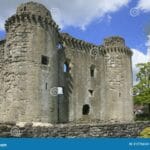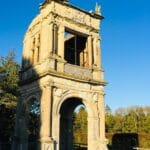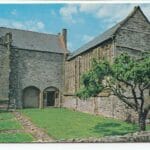Farleigh Hungerford Castle, nestled in the Somerset countryside, is more than just a ruin; it’s a captivating journey through time. Built by the powerful Hungerford family, starting in 1377, this remarkably well-preserved fortress reveals centuries of history, from medieval might to a slow, poignant decline. This guide explores its story, architecture, and the lives lived within its walls, offering a comprehensive look at this fascinating Somerset landmark. Explore its history, architecture, and the secrets held within its walls.
A Family Legacy Etched in Stone: The Rise and Fall of the Hungerfords
The story begins with Sir Thomas Hungerford, a prominent figure in the court of John of Gaunt, who commenced construction around 1377. By 1383, the imposing inner courtyard, a testament to the Hungerfords’ growing influence, stood complete. The castle’s design, though somewhat old-fashioned for its era, reflects the architectural styles of the late 14th century. Skilled craftsmen, shaping massive stones, likely echoed through the valley – a monumental undertaking for that time. The castle’s history is inextricably linked to the Hungerfords’ fortunes, with additions and modifications reflecting their successes and setbacks over the next three centuries. One can only speculate how different the castle might look today had the family’s power remained unchallenged.
Medieval Architecture and Defense
Farleigh Hungerford Castle’s impressive square design, with its strong, durable stone, was a clear statement of defensive strength. One can easily imagine archers manning the battlements, ready to repel any attack. Even in its ruined state, the sheer scale of the structure is breathtaking. The castle’s architectural details, however worn by time, suggest clever defensive planning. The exact construction methods might never be fully known, however, architectural historians may uncover more secrets within those ancient walls. It’s also interesting to consider how the castle’s design changed over time, evolving with architectural trends and the needs of successive owners.
What Happened to Farleigh Hungerford Castle? A Story of Survival and Decline
The tale of Farleigh Hungerford Castle is one of remarkable resilience and inevitable decay. Let’s explore its journey from a powerful family’s home to the poignant ruin we see today.
A Powerful Family’s Home (c. 1377-1640)
Farleigh Hungerford Castle, constructed between 1377 and 1383 by Sir Thomas Hungerford, served as a powerful symbol of the family’s wealth and influence for over three hundred years. Its old-fashioned design, unusual for its era, represented a bold statement of the Hungerford’s status. Generations of Hungerfords, their families, and numerous servants lived and worked within these walls; it’s easy to imagine the lives lived—celebrations, tragedies, and the daily routines—within those very stones.
The English Civil War: A Pivotal Turning Point (1643-1645)
The English Civil War brought upheaval, with many castles destroyed to prevent their use by opposing forces. Farleigh Hungerford, however, surprisingly survived. Captured by Royalists in 1643 and subsequently retaken by Parliamentarians in 1645, it avoided the fate of “slighting” (deliberate demolition). Why? Perhaps pragmatic considerations led the Parliamentarians to preserve it for strategic reasons; or maybe it was simply a fortunate accident. Historians continue to debate the reasons, adding to the castle’s enigmatic appeal.
The Slow, Unseen Decay (Post-1730)
Despite surviving the war, a slow decline began around 1730, a gradual process driven by neglect, changing ownership, and the relentless forces of nature. The detailed research of individuals such as the Revd J.E. Jackson in the 19th century helps illuminate this period of slow deterioration, offering valuable insights into the castle’s gradual fading. This period shows how even the most formidable structures eventually succumb to time.
The Castle Today: A Ruin Preserved
Today, Farleigh Hungerford Castle stands as a powerful testament to the past. While a ruin, its grandeur remains undeniable. English Heritage actively works to preserve the remaining structures, notably the remarkably well-preserved chapel. A visit offers a chance to walk through history, imagining the lives lived within those ancient walls and reflecting on the legacy of the Hungerford family. Ongoing research continues to reveal new details, assuring that the story of Farleigh Hungerford Castle remains a subject of active investigation.
What are the Holes in the Coffins at Farleigh Hungerford Castle?
One of Farleigh Hungerford Castle’s most intriguing features is the crypt beneath the north chapel and its eight anthropoid (human-shaped) lead coffins. These are not just coffins; they’re a fascinating study in 17th-century burial practices and the beliefs surrounding death. The carefully drilled holes are particularly captivating.
A Grisly Ritual?
The most prevalent theory suggests the holes were part of a gruesome 17th-century practice: extracting a “corpse-infused spirit,” possibly a morbid attempt to extract some essence of the deceased. This suggests a ritualistic purpose, highlighting the unsettling beliefs of that era. However, the holes might have served other purposes—perhaps to release gases, a practical approach to prevent pressure buildup, to aid in decomposition from a religious perspective, or something else entirely.
The Hungerfords’ Final Resting Place
These lead coffins housed members of the Hungerford family, including notable figures such as Sir Edward Hungerford III (d. 1648) and his son, Sir Edward Hungerford IV, known as “The Spendthrift.” Their final resting place offers a chilling glimpse into the lives of the English aristocracy and the beliefs surrounding death in the 17th century.
Ongoing Research and Unanswered Questions
Despite the common “corpse-infused spirit” theory, other hypotheses exist. Scientific analysis, including DNA testing and advanced imaging techniques, may eventually shed more light on these mysterious holes. The mystery surrounding these coffins highlights the ongoing research and the limitations of current knowledge surrounding the practices they signify.
Who Lived in Farleigh Hungerford Castle? A Tapestry of Lives
Farleigh Hungerford Castle was never just stones and mortar; it was home to generations of people over centuries. This section explores the lives of the Hungerfords and those who shared their lives within the castle’s walls.
The Hungerford Family: Lords of the Manor (1370-17th Century)
Sir Thomas Hungerford, the first Speaker of the House of Commons, acquired the Manor in 1369–70. His descendants, a colorful cast of characters, lived at Farleigh Hungerford Castle for over three hundred years, their lives inextricably intertwined with the castle’s history. Imagine bustling kitchens, quiet hallways, and important meetings in the great hall—what stories unfolded behind those thick walls?
More Than Just the Family: A Community Within
While the Hungerfords were the prominent family, many others called the castle home. Servants, craftsmen, and visitors all contributed to the castle’s vibrant life. Historical records might not capture the stories of each individual perfectly, but ongoing research and archeological investigation may help to better illustrate the community that existed within the castle walls. The castle’s population likely fluctuated throughout the year, depending upon the season, special events such as feasts and weddings, or significant visitors. The castle’s size suggests it was more than a family home; it housed a small community within its walls.
The End of an Era, but Not the End of the Story
By the 17th century, the Hungerfords’ fortunes shifted, leading to the sale of the castle. This marked the beginning of its decline, a process that has continued until our modern day. However, the history continues to be researched and debated.
Visiting Farleigh Hungerford Castle Today
Today, English Heritage cares for Farleigh Hungerford Castle. The ruins stand as a testament to the past, offering visitors a chance to explore the remnants of a powerful family’s home and imagine the vibrant lives that once filled its halls. [https://www.lolaapp.com/kirkham-priory] and [https://www.lolaapp.com/iran-takht-jamshid] offer further examples of historical sites where one can imagine the lives of those who previously lived there.
Key Takeaways:
- Farleigh Hungerford Castle’s construction, starting in 1377 by Sir Thomas Hungerford, reflected the family’s growing power.
- Its square design and durable construction prioritized defense.
- The castle’s design evolved over time, reflecting changing architectural styles and the influence of subsequent owners.
- Practical visitor information is available on the English Heritage website.
- The nearby village of Farleigh Hungerford offers further insight into medieval life.
- Comparing Hungerford Farleigh Castle to other medieval castles helps highlight its unique characteristics and architectural style.
Remember to visit the English Heritage website for the most up-to-date information on visiting Farleigh Hungerford Castle.














